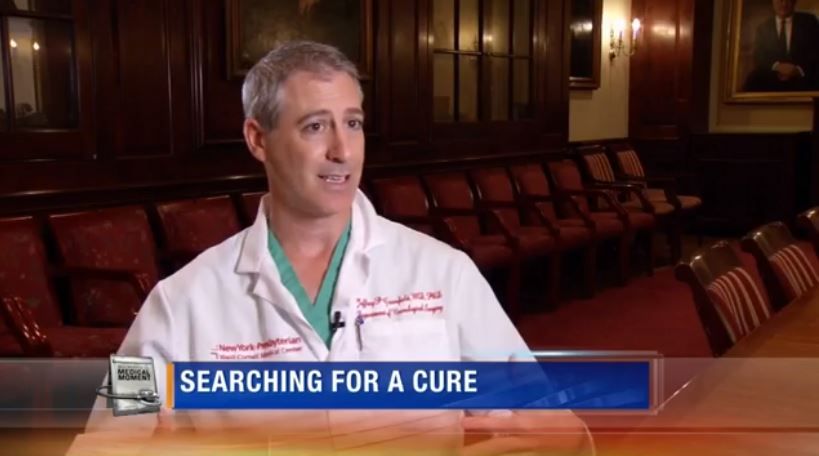DIPG: Searching for a Cure
This story and related interview were reported by Ivanhoe Broadcast News. Read the original articles here and the video below.
Diffuse intrinsic pontine glioma or DIPG, is an invasive pediatric brain cancer…a tumor in the brain stem that is impossible to safely remove. Radiation and traditional chemotherapy may buy a patient some time, but ultimately, can’t save a child’s life. Luckily, researchers are testing a new way to deliver cancer-fighting drugs that may someday soon lead to a cure.
Cristian Rivera’s bedroom is filled with trains. Like many boys, he played sports and loved things that moved. It’s a place that his father, John, has frozen in time. The family has kept everything the same for six years. Doctors diagnosed Cristian with DIPG at age four. He was six when he died.
“It was a very bad feeling to be helpless and to watch something you love so much, the person you love so much suffer and diminish, right before your eyes,” John told Ivanhoe.
For decades, doctors have had a difficult time treating DIPG. The tumor grows near a delicate part of the brain stem that controls breathing and heart rate.
Doctors also say the brain has a self-protective feature called the blood-brain barrier, a natural roadblock that keeps medications from going to the brain and the brain tumor.
Pediatric neurosurgeon Jeffrey Greenfield, MD, at Weill Cornell Medicine in New York explained, “So you give all these toxic chemotherapies and get all the terrible side effects, but you don’t get any of the penetration into the brain.”
Mark Souweidane, MD, Director of Pediatric Neurosurgery at Weill Cornell Medicine in New York is researching a new procedure that would bypass that barrier.
“What we have been investigating is taking small cannula, or small tiny-like, hair-like structures, much smaller than a drinking straw that basically go into the brain tumor itself, and through that we infuse the therapeutic molecule,” Dr. Souweidane said.
Dr. Souweidane is leading a small clinical trial of the procedure. If the delivery system is proven safe, more patients could be treated in a second phase.
He said, “I don’t think it’s being short-sighted, but I entirely expect to see a cure in my lifetime.”
John told Ivanhoe, “I ultimately want to see a cure. I don’t want to see kids suffer.”
John Rivera established the Cristian Rivera foundation to provide support for other families with children who have been diagnosed with DIPG. The foundation has also raised more than $500,000 since Cristian’s death for DIPG research.
BACKGROUND: Diffuse Intrinsic Pontine Glioma, known as DIPG, is a highly aggressive brain tumor that accounts for 10 percent of all childhood central nervous system tumors. Each year about 300 children, typically aged five to nine, are diagnosed with DIPG. The tumor is a glioma which means it is a tumor that comes from the glial tissue, the brain support tissue that protects the neurons in the brain. Some of the most common symptoms of DIPG are double vision, inability to completely close the eye lids, drooping on one side of the face and difficulty chewing and swallowing. This tumor is one of the most resistant of all cancers to chemotherapy and tends to progress rapidly in the brain stem.
TREATMENTS: Like many glioma tumors, DIPG can be classified in stages or “grades”. The four stages of gliomas are:
- Grade I (pilocytic)
- Grade II (fibrillary)
- Grade III (anaplastic)
- Grade IV (glioblastoma multiforme)
DIPG usually receives a grade III or IV when first biopsied because of its fast progression. DIPG is diagnosed using imaging scans. Doctors will order a computerized tomography (CT) scan or magnetic resonance imaging (MRI) with magnetic resonance spectroscopy (MRS). These tests take detailed images of the body in order to identify the size and location of the tumor in the brain.
NEW TECHNOLOGY: Since the brain has a self-protective feature called the blood-brain barrier which is a natural roadblock that keeps medications from going to the brain and brain tumor, doctors are now researching a new procedure that would bypass that barrier. This would avoid all systemic drug exposure and eliminate chemotherapeutic toxicity. Mark Souweidane, MD, Vice Chairman of the Department of Neurological Surgery at Weill Cornell Medicine in New York is leading a small clinical trial of the procedure. If the delivery system is proven safe, more patients could be treated in a second phase. Dr. Souweidane says, “Once safety is established, then the strategy could be applied to later phase clinical trials designed to look at tumor efficacy and provide a method of delivery that would be applicable for a host of novel agents including virus, monoclonal antibody, small molecule inhibitors and delivery vehicles.
DIPG: Searching for a Cure -- Doctor's In-depth Interview
Mark Souweidane, M.D., Professor and Vice Chairman in the Department of Neurological Surgery at Weill Cornell Medicine talks about research in diffuse intrinsic pontine glioma (DIPG).
Interview conducted by Ivanhoe Broadcast News in September 2015
I want to ask about DIPG, is this considered a rare childhood cancer?
Dr. Souweidane: Depends who you ask, rare in the big picture, rare in the world of viewing things in a global method. Very, very common in my practice, very common in pediatric neuro-oncology. So I’m sure you have some of the stats but in general about 200 cases a year diagnosed in North America. So again very rare in the big picture, especially from the standpoint of funding agencies and pharmacology and I mean pharma. So very, very focused in certain realms such as my clinical practice and research endeavor, but a rare tumor.
And universally fatal.
Dr. Souweidane: Universally fatal, yes. I mean the ability to diagnose it is pretty darn good today from the standpoint of the accuracy of diagnosis based on history and the radiographic or MRI findings. And with that signature, pretty much an invariable outcome. That’s going to be a fatal outcome.
I want to ask what you’re looking at in your lab in terms of clinical trials. Are you currently in the middle of a Phase I or have you just wrapped up Phase I?
Dr. Souweidane: Pretty close to completing the first Phase I clinical trial. The research endeavor for me has always been focused on DIPG. And there’s a lot of reasons why I chose that as a disease entity. First, and foremost, because of the frustration in dealing with that disease and not offering a parent and child the type of hope and optimism that we normally get with a pediatric brain tumor. The fact that we can cure other cancers with a pretty good clip and efficiency, up to 80 percent of the more malignant tumors in children that we see in the brain. It would mean that there has to be more effort put in to this particular tumor, and that dates back you know between 15 and 20 years as far as the thought process and the level of frustration. And that was the genesis and then as far as the research itself what we try to do is merge a very basic concept in oncology with diffuse intrinsic pontine glioma and that is the inability to get chemotherapeutic agents or other effective therapeutic agents in to the brain tumor itself or even in to the brain.
Why is that, why is it difficult to deliver to the brain?
Dr. Souweidane: The brain is unique unlike any other organ system in the body. It is a privileged site that is entirely separate from the blood circulation. And because of that barrier, which is referred to as the blood brain barrier, most therapeutic agents cannot get in to the brain and hence, the brain tumor itself. DIPG is further unique in that it doesn’t show the very typical contrast enhancement of a lot of tumors. The contrast enhancement is a very good correlative, what we call the breakdown of the blood brain barrier like other malignancies we see in the brain. That’s not the case with DIPG, so that’s even added the need for identifying a method or a more efficient method for getting drugs in to the diffuse intrinsic pontine glioma that wouldn’t get there with systemic circulation.
So what are you doing to deliver those drugs?
Dr. Souweidane: What we have done, there’s been close to 15 years of preclinical work addressing this issue and testing the feasibility, but it’s trying to get around this idea that there is a barrier, that there is a hindrance with regard to delivering therapeutic molecules. So we’ve taken a different approach that was toyed around and played with in very, very small research endeavors prior to 1995, 1997, when we started this toward the brain stem and brain stem tumors was the portfolio of my research mission. What we have been investigating is taking small cannula, or small tiny like hair like structures, much, much smaller than a drinking straw, that basically go in to the brain tumor itself and through that we infuse a therapeutic molecule. That, expectedly, at that time in the research design was thought to be somewhat on the verge of lunacy just because you’re putting something like that in to the brain stem and then infusing something that would take up volume. So the potential risk and the concern was huge, so I spent a good decade defining what that safety perimeter would look like. Identifying catheters that are designed for that purpose, calibrating things in a very, very small scale, looking into different therapeutic molecules with regard to potential toxicity. In essence, what we’re doing is reversing the normal problem and giving something systemically where a fraction of a percent might get into the brain and now, flipping that around so that we’re establishing methods for getting compounds in to the brain with an efficiency that is 1000, 1500 times greater than what we would normally be able to do. And with no systemic exposure what so ever. So we eliminated essentially systemic toxicity, bone marrow suppression, renal toxicity and other avenues of oncology that have been very problematic in the growing child. We’ve entirely eliminated that and then we’ve entirely addressed the idea of bypassing the blood brain barrier with this concept. And that’s what the lab had focused on for a good decade.
Where are you now in terms of that research?
Dr. Souweidane: That research, fortunately, culminated and is in a Phase I clinical trial. It gave me the confidence from the standpoint of the primary mission of that laboratory investigation. That was for safety issues so given that these kids have no therapeutic alternative, there’s a sense of desperation, there’s a sense of acceptance about being innovative and adventurous and designing a clinical trial. But really the emphasis on the laboratory work was to establish safety. And that was in small animals, larger animals, primates and a lot of information addressing the idea whether we could do this and do this safely. That has transitioned into a clinical trial, we spent approximately two years designing what I consider to be an optimal clinical trial, and then about the same time span, two to three years, getting regulatory approval, getting funding. The first patient was treated in May of 2012 on that trial and seven dose levels is the way we kind of define Phase I studies. We are currently on the verge of completing our sixth dose level and have to say that these built around the idea of establishing safety has been very, very efficient from the standpoint of not seeing any treatment-related, toxicity-based on the way we designed this trial. So, essentially, it’s opening up the door to a whole array of therapeutic compounds now that we hope to align with and say that we’ve got a method for delivering, we have a method for identifying and we have a way a very highly effective means of eliminating systemic toxicity. Now let’s put our minds together as far optimizing the oncologic potential of this. So I’m happy to say that we’re three years into it and so far it’s been fabulous from the standpoint of the toxicity profile.
So, you’re to the point where you need to find the right agent to interact, to deliver?
Dr. Souweidane: Yes, whether we have found the right agent or we need to find the right agent is still unsaid. So the basis of this particular trial, as any Phase I study, is to identify a dose that we either think, have seen or some rational for believing that it’s going to be effective. And then what we do is monitor that design, that therapeutic design or strategy into a comparative analysis. We’re not quite there as far as what we consider to be an optimal drug dose because we haven’t seen any toxicity. The thought concept is, you push a little higher, you push a little higher, and when you see that lack of wiggle room, then you use that as your therapeutic design to integrate in to a Phase II study, in a comparative way.
I know it may be very difficult to pinpoint but could you give us a timeframe as to when you might begin to a Phase II or Phase III, where there really might be breaking through to new ground?
Dr. Souweidane: I personally think we have broken into new ground. There’s a huge, in my mind, evolution of where we’ve gone over the past three years. And so when I started this in a research endeavor, not naysayers but there was a lot of critique about the concept of doing this. We’re now doing this in human subjects and children and have been doing it for three years with highly successful monitoring purpose from the standpoint of safety. We haven’t hurt anybody under the design and under the perimeters of the study in which its been built. So that’s a huge step forward with regard to offering the oncology world, and not just the patient, but the oncology world, a portfolio in which they can build on. So whether we have the right agent or not is left unsaid, that’s my hope that we don’t have to look for other agents. My hope is that as we get to these higher dose levels, we’re done with the design of this. True, there’s going to be a lot of optimization, there’s no question about it. There might be integration of other agents, there might be scheduling issues that would demand repeated doses, longer duration of infusion, it’s entirely unknown right now. But those are the concepts that are, in my mind, infiltrating the design of the next step. With regard to Phase II studies, clearly, if we see safety in the last dose level that we think should be effective, then our next step is to establish a Phase II study, there’s no question. Paralleling that the lab is entirely and highly aggressive right now about looking at other therapeutic compounds that we can deliver with this mechanism, in the event that we’re not happy with the results that we’re seeing in a Phase I or Phase II study with this particular compound. We’re doing that currently, we’re currently paving the way for other Phase I studies for this disease with other compounds, different scheduling schemes, etc.
Do you anticipate that you would see a treatment or a cure in your lifetime?
Dr. Souweidane: Yes. Every day, I wake up and I look at my E-mail and I see an E-mail from a parent or somebody else in the clinical trial with me and you always hold your breath. Is it the glimmer of hope that we’ve been waiting for? Is it more bad news? Is it a revelation with regard to a new compound that we can now offer very effective means of that therapeutic delivery? But I think it would be, I wouldn’t say short-sighted, but it’s frustrating, no question about it. It’s hard to go to work the next day and it’s hard to go back in the laboratory, week after week, and it’s hard to look for investors to give you another million dollars to drive another clinical trial, if in your heart of heart, you don’t believe it’s going to be effective. So I don’t think it’s being short-sighted, but I entirely expect to see cure in my lifetime. We’ve seen a lot of variability with our trial with regard to length of survival after treatment. Trying to harness why those differences exist would be very useful to understand. But I entirely expect to see that, I really do. I don’t think that’s being ignorant or glossing over anything in any way, shape or form. But I’ve been in this field for over two decades and I’ve watched the transition from absolutely no interest in this disease, for all the obvious reasons. No funding, no element of success, the frustration, the despair all of those things exist and did exist. And now it’s probably DIPG at the forefront of some of the most intensive research and investigative efforts we’ve seen in pediatric neuro-oncology. One of the most, best defined tumors with regard to molecular and genomic characterizations, one of the most aggressive forms of collaborative efforts coming together worldwide to try and address some of these issues and optimize these ideas. So I fully expect it’s going to happen. There’s a lot of very smart, intelligent people working on this disease that didn’t exist 10, 15 years ago. And the playing field has changed dramatically.





